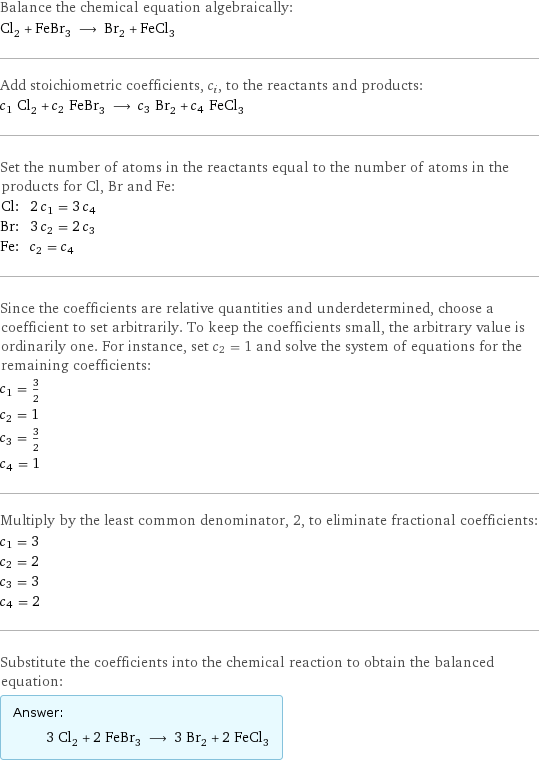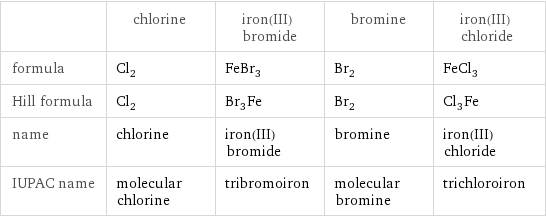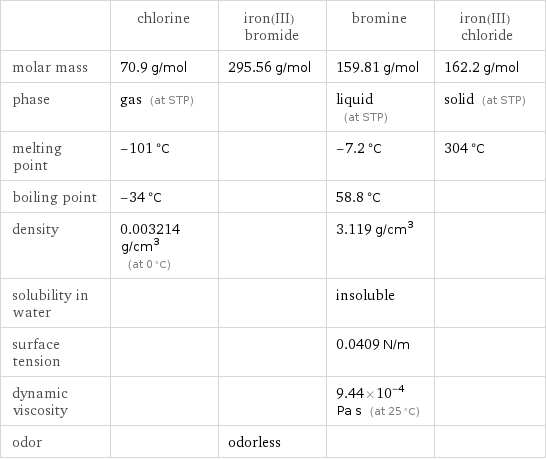Input interpretation

Cl_2 chlorine + FeBr_3 iron(III) bromide ⟶ Br_2 bromine + FeCl_3 iron(III) chloride
Balanced equation

Balance the chemical equation algebraically: Cl_2 + FeBr_3 ⟶ Br_2 + FeCl_3 Add stoichiometric coefficients, c_i, to the reactants and products: c_1 Cl_2 + c_2 FeBr_3 ⟶ c_3 Br_2 + c_4 FeCl_3 Set the number of atoms in the reactants equal to the number of atoms in the products for Cl, Br and Fe: Cl: | 2 c_1 = 3 c_4 Br: | 3 c_2 = 2 c_3 Fe: | c_2 = c_4 Since the coefficients are relative quantities and underdetermined, choose a coefficient to set arbitrarily. To keep the coefficients small, the arbitrary value is ordinarily one. For instance, set c_2 = 1 and solve the system of equations for the remaining coefficients: c_1 = 3/2 c_2 = 1 c_3 = 3/2 c_4 = 1 Multiply by the least common denominator, 2, to eliminate fractional coefficients: c_1 = 3 c_2 = 2 c_3 = 3 c_4 = 2 Substitute the coefficients into the chemical reaction to obtain the balanced equation: Answer: | | 3 Cl_2 + 2 FeBr_3 ⟶ 3 Br_2 + 2 FeCl_3
Structures

+ ⟶ +
Names

chlorine + iron(III) bromide ⟶ bromine + iron(III) chloride
Equilibrium constant
![Construct the equilibrium constant, K, expression for: Cl_2 + FeBr_3 ⟶ Br_2 + FeCl_3 Plan: • Balance the chemical equation. • Determine the stoichiometric numbers. • Assemble the activity expression for each chemical species. • Use the activity expressions to build the equilibrium constant expression. Write the balanced chemical equation: 3 Cl_2 + 2 FeBr_3 ⟶ 3 Br_2 + 2 FeCl_3 Assign stoichiometric numbers, ν_i, using the stoichiometric coefficients, c_i, from the balanced chemical equation in the following manner: ν_i = -c_i for reactants and ν_i = c_i for products: chemical species | c_i | ν_i Cl_2 | 3 | -3 FeBr_3 | 2 | -2 Br_2 | 3 | 3 FeCl_3 | 2 | 2 Assemble the activity expressions accounting for the state of matter and ν_i: chemical species | c_i | ν_i | activity expression Cl_2 | 3 | -3 | ([Cl2])^(-3) FeBr_3 | 2 | -2 | ([FeBr3])^(-2) Br_2 | 3 | 3 | ([Br2])^3 FeCl_3 | 2 | 2 | ([FeCl3])^2 The equilibrium constant symbol in the concentration basis is: K_c Mulitply the activity expressions to arrive at the K_c expression: Answer: | | K_c = ([Cl2])^(-3) ([FeBr3])^(-2) ([Br2])^3 ([FeCl3])^2 = (([Br2])^3 ([FeCl3])^2)/(([Cl2])^3 ([FeBr3])^2)](../image_source/a680d0313a8eb545deee6296698ac763.png)
Construct the equilibrium constant, K, expression for: Cl_2 + FeBr_3 ⟶ Br_2 + FeCl_3 Plan: • Balance the chemical equation. • Determine the stoichiometric numbers. • Assemble the activity expression for each chemical species. • Use the activity expressions to build the equilibrium constant expression. Write the balanced chemical equation: 3 Cl_2 + 2 FeBr_3 ⟶ 3 Br_2 + 2 FeCl_3 Assign stoichiometric numbers, ν_i, using the stoichiometric coefficients, c_i, from the balanced chemical equation in the following manner: ν_i = -c_i for reactants and ν_i = c_i for products: chemical species | c_i | ν_i Cl_2 | 3 | -3 FeBr_3 | 2 | -2 Br_2 | 3 | 3 FeCl_3 | 2 | 2 Assemble the activity expressions accounting for the state of matter and ν_i: chemical species | c_i | ν_i | activity expression Cl_2 | 3 | -3 | ([Cl2])^(-3) FeBr_3 | 2 | -2 | ([FeBr3])^(-2) Br_2 | 3 | 3 | ([Br2])^3 FeCl_3 | 2 | 2 | ([FeCl3])^2 The equilibrium constant symbol in the concentration basis is: K_c Mulitply the activity expressions to arrive at the K_c expression: Answer: | | K_c = ([Cl2])^(-3) ([FeBr3])^(-2) ([Br2])^3 ([FeCl3])^2 = (([Br2])^3 ([FeCl3])^2)/(([Cl2])^3 ([FeBr3])^2)
Rate of reaction
![Construct the rate of reaction expression for: Cl_2 + FeBr_3 ⟶ Br_2 + FeCl_3 Plan: • Balance the chemical equation. • Determine the stoichiometric numbers. • Assemble the rate term for each chemical species. • Write the rate of reaction expression. Write the balanced chemical equation: 3 Cl_2 + 2 FeBr_3 ⟶ 3 Br_2 + 2 FeCl_3 Assign stoichiometric numbers, ν_i, using the stoichiometric coefficients, c_i, from the balanced chemical equation in the following manner: ν_i = -c_i for reactants and ν_i = c_i for products: chemical species | c_i | ν_i Cl_2 | 3 | -3 FeBr_3 | 2 | -2 Br_2 | 3 | 3 FeCl_3 | 2 | 2 The rate term for each chemical species, B_i, is 1/ν_i(Δ[B_i])/(Δt) where [B_i] is the amount concentration and t is time: chemical species | c_i | ν_i | rate term Cl_2 | 3 | -3 | -1/3 (Δ[Cl2])/(Δt) FeBr_3 | 2 | -2 | -1/2 (Δ[FeBr3])/(Δt) Br_2 | 3 | 3 | 1/3 (Δ[Br2])/(Δt) FeCl_3 | 2 | 2 | 1/2 (Δ[FeCl3])/(Δt) (for infinitesimal rate of change, replace Δ with d) Set the rate terms equal to each other to arrive at the rate expression: Answer: | | rate = -1/3 (Δ[Cl2])/(Δt) = -1/2 (Δ[FeBr3])/(Δt) = 1/3 (Δ[Br2])/(Δt) = 1/2 (Δ[FeCl3])/(Δt) (assuming constant volume and no accumulation of intermediates or side products)](../image_source/03f587b82cc832065c7d69a544f2f344.png)
Construct the rate of reaction expression for: Cl_2 + FeBr_3 ⟶ Br_2 + FeCl_3 Plan: • Balance the chemical equation. • Determine the stoichiometric numbers. • Assemble the rate term for each chemical species. • Write the rate of reaction expression. Write the balanced chemical equation: 3 Cl_2 + 2 FeBr_3 ⟶ 3 Br_2 + 2 FeCl_3 Assign stoichiometric numbers, ν_i, using the stoichiometric coefficients, c_i, from the balanced chemical equation in the following manner: ν_i = -c_i for reactants and ν_i = c_i for products: chemical species | c_i | ν_i Cl_2 | 3 | -3 FeBr_3 | 2 | -2 Br_2 | 3 | 3 FeCl_3 | 2 | 2 The rate term for each chemical species, B_i, is 1/ν_i(Δ[B_i])/(Δt) where [B_i] is the amount concentration and t is time: chemical species | c_i | ν_i | rate term Cl_2 | 3 | -3 | -1/3 (Δ[Cl2])/(Δt) FeBr_3 | 2 | -2 | -1/2 (Δ[FeBr3])/(Δt) Br_2 | 3 | 3 | 1/3 (Δ[Br2])/(Δt) FeCl_3 | 2 | 2 | 1/2 (Δ[FeCl3])/(Δt) (for infinitesimal rate of change, replace Δ with d) Set the rate terms equal to each other to arrive at the rate expression: Answer: | | rate = -1/3 (Δ[Cl2])/(Δt) = -1/2 (Δ[FeBr3])/(Δt) = 1/3 (Δ[Br2])/(Δt) = 1/2 (Δ[FeCl3])/(Δt) (assuming constant volume and no accumulation of intermediates or side products)
Chemical names and formulas

| chlorine | iron(III) bromide | bromine | iron(III) chloride formula | Cl_2 | FeBr_3 | Br_2 | FeCl_3 Hill formula | Cl_2 | Br_3Fe | Br_2 | Cl_3Fe name | chlorine | iron(III) bromide | bromine | iron(III) chloride IUPAC name | molecular chlorine | tribromoiron | molecular bromine | trichloroiron
Substance properties

| chlorine | iron(III) bromide | bromine | iron(III) chloride molar mass | 70.9 g/mol | 295.56 g/mol | 159.81 g/mol | 162.2 g/mol phase | gas (at STP) | | liquid (at STP) | solid (at STP) melting point | -101 °C | | -7.2 °C | 304 °C boiling point | -34 °C | | 58.8 °C | density | 0.003214 g/cm^3 (at 0 °C) | | 3.119 g/cm^3 | solubility in water | | | insoluble | surface tension | | | 0.0409 N/m | dynamic viscosity | | | 9.44×10^-4 Pa s (at 25 °C) | odor | | odorless | |
Units
